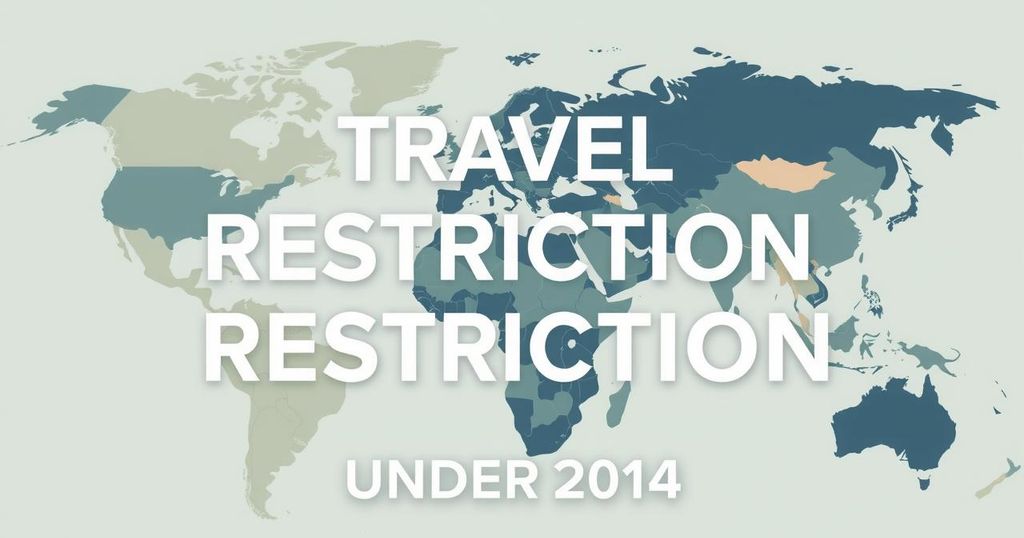Global news
AFRICA, CUBA, DEFENSE, DEPORTATION, GEOPOLITICS, INTERNATIONAL RELATIONS, MYANMAR, NATIONAL SECURITY, NEW YORK TIMES, NORTH AMERICA, OFFICE OF THE DIRECTOR OF NATIONAL INTELLIGENCE, SIERRA LEONE, SOUTH AMERICA, STATE DEPARTMENT, STATE DEPARTMENT ’, SUDAN, TRUMP, UNITED STATES, VENEZUELA
Marcus Li
0 Comments
Trump Administration Proposes Expanded Travel Ban Affecting 43 Countries
The Trump administration is proposing a new travel ban affecting citizens from 43 countries, expanding previous restrictions. A ‘red’ list includes 11 nations prohibited from entry, while an ‘orange’ list outlines countries with restricted access. Additionally, a ‘yellow’ list highlights countries needing to address security deficiencies. The implications of these actions on existing visas and relations are yet to be determined.
The Trump administration is currently contemplating a broader travel ban that could impact citizens of up to 43 countries. This proposed ban may be more expansive than those enacted during President Trump’s initial term. According to anonymous officials familiar with the situation, a draft list has been compiled that includes a “red” list of 11 countries whose citizens would be entirely prohibited from entering the United States, namely Afghanistan, Bhutan, Cuba, Iran, Libya, North Korea, Somalia, Sudan, Syria, Venezuela, and Yemen.
State Department officials and security experts have been reviewing the proposed travel restrictions, providing feedback on the classifications of various countries. It is essential to note that this draft originated several weeks ago and may undergo modifications prior to submitting it to the White House. Currently, there is also an “orange” list, comprised of 10 nations where travel may be restricted but not entirely prohibited. Citizens from these countries may still enter if they are affluent business travelers, albeit with stringent visa interview requirements.
The “orange” list includes Belarus, Eritrea, Haiti, Laos, Myanmar, Pakistan, Russia, Sierra Leone, South Sudan, and Turkmenistan. This list aims to address deficiencies within these nations or to avoid jeopardizing other cooperative efforts. The Trump administration previously issued an executive order mandating the identification of countries that required enhanced vetting processes, reflecting ongoing national security concerns.
As the proposed ban evolves, the exemption status for individuals holding existing visas, as well as green card holders, remains uncertain. Recent actions by the administration, including the revocation of a green card for a Syrian-born individual, spotlight the contentious nature of these travel restrictions. Countries on the current list typically exhibit characteristics such as being predominantly Muslim, economically disadvantaged, and possessing unstable governments. However, the rationale behind the inclusion of nations like Bhutan is less transparent.
In addition to the red and orange lists, a “yellow” list has been proposed, which encompasses 22 countries that will be given 60 days to address perceived deficiencies in security and information sharing. Failure to comply may result in these nations being moved to more restrictive categories. Countries on this yellow list include Angola, Cambodia, and Zimbabwe, among others.
Historically, the first two iterations of Trump’s travel ban faced judicial challenges before a revised version was ultimately sanctioned by the Supreme Court. In contrast, President Biden revoked these bans shortly after taking office, deeming them a statement against the United States’ commitment to diversity and inclusivity.
Trump’s ongoing efforts to revive these travel restrictions underscore his administration’s view that they are essential to safeguarding national security against potential threats from foreign nationals.
In summary, the proposed travel ban under the Trump administration aims to target citizens of up to 43 countries, with distinct classifications for restrictions. The intricacies of these lists highlight the administration’s focus on national security, yet raise questions regarding fairness and transparency. As legal and diplomatic implications unfold, both domestic and international observers remain attentive to how these developments shape the future of U.S. immigration policy.
Original Source: newsroom.gy




Post Comment